Targeting estrogen-related receptor alpha inhibits epithelial-to-mesenchymal transition and stem cell properties of ovarian cancer cells
- PMID: 24419103
- PMCID: PMC3982489
- DOI: 10.1038/mt.2014.1
Targeting estrogen-related receptor alpha inhibits epithelial-to-mesenchymal transition and stem cell properties of ovarian cancer cells
Abstract
Epithelial-mesenchymal transition represents a key event in cancer progression and has emerged as a promising anticancer target. Estrogen-related receptor alpha (ERRα) is frequently elevated in advanced-stage ovarian cancer, but its potential role in tumor progression is not known. Here we show that ERRα functions in epithelial-mesenchymal transition and in subsequent stem cell traits responsible for the acquisition of high degree of aggressiveness and potential for metastasis that are characteristic of ovarian cancer. Importantly, targeted inhibition of ERRα also inhibited the expression of Snail, a repressor of E-cadherin and an inducer of epithelial-mesenchymal transition. Interestingly, induction of Snail resulted from not only changes in mRNA transcription rate but also mRNA stability. We thus identified the miR-200 family as a new player in the ERRα-mediated posttranscriptional regulation of Snail, and antagonism of miR-200a/b could revert the decreased expression of Snail and reversal of epithelial-mesenchymal transition and stem cell characteristics due to ERRα depletion. Finally, we showed that RNA interference-mediated inhibition of ERRα significantly reduced tumor burden, ascites formation, and metastatic peritoneal nodules in vivo in an orthotopic model of ovarian cancer. These results suggest ERRα activation as a mechanism of tumor aggressiveness and imply that targeting ERRα may be a promising approach in ovarian cancer treatment.
Figures
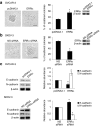

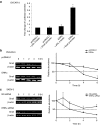

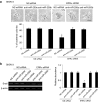
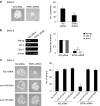
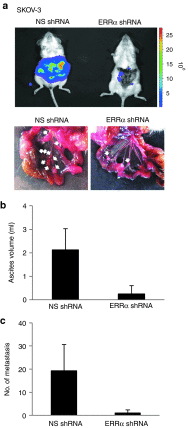
Similar articles
-
Inhibition of ERRα suppresses epithelial mesenchymal transition of triple negative breast cancer cells by directly targeting fibronectin.Oncotarget. 2015 Sep 22;6(28):25588-601. doi: 10.18632/oncotarget.4436. Oncotarget. 2015. PMID: 26160845 Free PMC article.
-
Estrogen-related receptor-α promotes gallbladder cancer development by enhancing the transcription of Nectin-4.Cancer Sci. 2020 May;111(5):1514-1527. doi: 10.1111/cas.14344. Epub 2020 Feb 29. Cancer Sci. 2020. PMID: 32030850 Free PMC article.
-
Estrogen-related receptor alpha (ERRα) promotes the migration, invasion and angiogenesis of breast cancer stem cell-like cells.Med Oncol. 2024 Feb 23;41(3):78. doi: 10.1007/s12032-024-02329-1. Med Oncol. 2024. PMID: 38393411
-
Epithelial-mesenchymal transition-associated miRNAs in ovarian carcinoma, with highlight on the miR-200 family: prognostic value and prospective role in ovarian cancer therapeutics.Cancer Lett. 2014 Sep 1;351(2):173-81. doi: 10.1016/j.canlet.2014.05.022. Epub 2014 Jun 18. Cancer Lett. 2014. PMID: 24952258 Review.
-
The epithelial-mesenchymal transition and the estrogen-signaling in ovarian cancer.Curr Drug Targets. 2010 Apr;11(4):474-81. doi: 10.2174/138945010790980385. Curr Drug Targets. 2010. PMID: 20015012 Review.
Cited by
-
Activation of GPER suppresses epithelial mesenchymal transition of triple negative breast cancer cells via NF-κB signals.Mol Oncol. 2016 Jun;10(6):775-88. doi: 10.1016/j.molonc.2016.01.002. Epub 2016 Jan 18. Mol Oncol. 2016. PMID: 26842883 Free PMC article.
-
Research progress of epithelial-mesenchymal transformation-related transcription factors in peritoneal metastases.J Cancer. 2024 Aug 19;15(16):5367-5375. doi: 10.7150/jca.98409. eCollection 2024. J Cancer. 2024. PMID: 39247601 Free PMC article. Review.
-
ERRα: unraveling its role as a key player in cell migration.Oncogene. 2024 Feb;43(6):379-387. doi: 10.1038/s41388-023-02899-w. Epub 2023 Dec 21. Oncogene. 2024. PMID: 38129506 Review.
-
Estrogen-related receptor alpha directly binds to p53 and cooperatively controls colon cancer growth through the regulation of mitochondrial biogenesis and function.Cancer Metab. 2020 Dec 10;8(1):28. doi: 10.1186/s40170-020-00234-5. Cancer Metab. 2020. PMID: 33303020 Free PMC article.
-
Inhibition of ERRα suppresses epithelial mesenchymal transition of triple negative breast cancer cells by directly targeting fibronectin.Oncotarget. 2015 Sep 22;6(28):25588-601. doi: 10.18632/oncotarget.4436. Oncotarget. 2015. PMID: 26160845 Free PMC article.
References
-
- Siegel R, Naishadham D, Jemal A. Cancer statistics, 2012. CA Cancer J Clin. 2012;62:10–29. - PubMed
-
- Giguère V, Yang N, Segui P, Evans RM. Identification of a new class of steroid hormone receptors. Nature. 1988;331:91–94. - PubMed
-
- Sun P, Wei L, Denkert C, Lichtenegger W, Sehouli J. The orphan nuclear receptors, estrogen receptor-related receptors: their role as new biomarkers in gynecological cancer. Anticancer Res. 2006;26 2C:1699–1706. - PubMed
-
- Fujimoto J, Alam SM, Jahan I, Sato E, Sakaguchi H, Tamaya T. Clinical implication of estrogen-related receptor (ERR) expression in ovarian cancers. J Steroid Biochem Mol Biol. 2007;104:301–304. - PubMed
-
- Thiery JP, Sleeman JP. Complex networks orchestrate epithelial-mesenchymal transitions. Nat Rev Mol Cell Biol. 2006;7:131–142. - PubMed
Publication types
MeSH terms
Substances
LinkOut - more resources
Full Text Sources
Other Literature Sources
Medical
Research Materials

